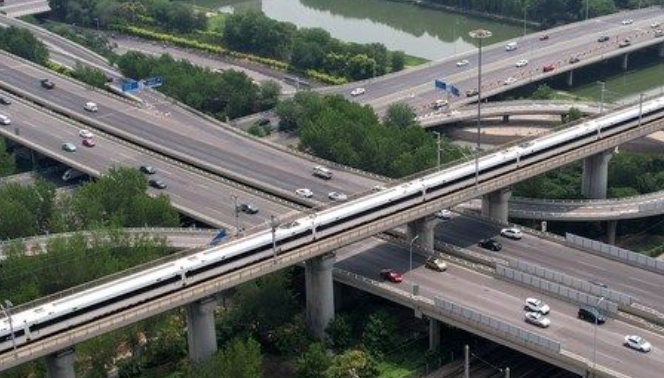In one minute in China, the "Fuxing" high-speed train travels 5.8 kilometers, 21 civil aviation flights take off from airports across the country, and couriers deliver 247,000 express packages.

This aerial photo taken on July 20, 2023 shows a train running along the Beijing-Tianjin Intercity Railway in the urban area of north China's Tianjin. (Photo: Xinhua)
In one hour in China, more than 1.08 million trips are taken by online ride-hailing cars and more than 1.9 million shared bikes travel through the streets.
In one day in China, 56,000 cargo ships enter and leave ports, and 48 China-Europe freight trains run along the Eurasia continent...
This vivid picture reflects the strong pulse and surging vitality of China's economy.
The freight market has recovered strongly. In the first 11 months of 2023, freight traffic volume totaled 50.02 billion tons, up 8.1 percent year-on-year, exceeding that of the whole year of 2019 before the pandemic. This scale is about 2.7 times the US freight volume.
Travel demand has rapidly increased. In the first 11 months of 2023, 55.59 billion inter-regional trips were made in China, up 34.8 percent year-on-year. Among these, passenger traffic on railroads, waterways and civil aviation all doubled.

This aerial photo taken on Oct. 2, 2023 shows a container ship docking at an automation wharf of Qinzhou Port for unloading in Qinzhou, south China's Guangxi Zhuang Autonomous Region. (Photo: Xinhua)
Today China has the most passenger and cargo traffic, the largest port cargo throughput, and the greatest volume for the express delivery business. It is deservedly the world's busiest country in terms of transportation.
As the world's busiest country in terms of transportation, China's strong transportation infrastructure is an important supporting force.
At the end of 2023, the Beijing-Xiong’an Expressway and Guanzhuang-Xinhua Expressway were opened to traffic, and the annual new, renovated and expanded highway mileage exceeded 7,000 kilometers; a number of new high-speed railway lines, such as the Guiyang-Nanning, Fuzhou-Xiamen, and Ji’nan-Zhengzhou railways were opened to traffic, while the main high-speed rail corridor of the "Eight Verticals and Eight Horizontals," 36,100 kilometers in total, was completed; all the main lines of the Shenzhen-Zhongshan Corridor were opened to traffic; and the entire construction of the Pinglu Canal entered the completion phase. Today China has built the world's largest high-speed railway network, highway network, postal express network and world-class ports. About 87 percent of the main skeleton line of the national transportation network has been completed, covering about 90 percent of the population and total economic volume.

This aerial photo taken on Jan. 1, 2024 shows vehicles running on the Jiangxinzhou Yangtze River bridge in Nanjing, east China's Jiangsu Province. (Photo: Xinhua)
Cargo vessels arriving and departing from ports, e-commerce on livestreaming platforms reaching remote mountainous rural areas and express delivery services stretching into factories, behind these new phenomena is the fact that the manufacturing industry and logistic industry met halfway.
On the coast of the East China Sea, at the Haitong Wharf in Shanghai's Waigaoqiao Port Area, vehicles that just rolled off the factory line have arrived at the pier to board the ship. The car transport ship is ready to set sail and carry nearly 5,000 domestically produced new energy vehicles to Europe. In 2023, as the country's largest car roll-on, roll-off wharf, the Haitong Wharf saw an average of nearly 3,000 cars set off on long voyages every day, becoming a vivid footnote showing that China's car export volume ranks first in the world.

A host promotes products via livestreaming during an exhibition of poverty alleviation achievement in southwest China's Xizang Autonomous Region on Oct. 19, 2020. (File photo: Xinhua)
On the snowy Qinghai-Xizang Plateau, in Damu village, Medog county, Nyingchi City of the Xizang Autonomous Region, the livestreams by Tibetan girl Gasongwangmu have attracted quite a few viewers.
“The red rice produced in Medog can be sent postage free to anywhere in the country now that the highway has come into operation, so we don’t have to worry about sales anymore,” Gasongwangmu said. As China’s last county to be connected to a highway, the GDP of Medog witnessed a jump in growth from 260 million yuan in 2012 to 790 million in 2022, in the 10 years since the Medog Highway opened to traffic.
The development of road, railway and civil aviation networks, slashed the distance between cities, linking tourist spots along routes, and fostering the continuous growth of the tourist economy.
Vivid scenes have written countless entrepreneurial stories: roads have been built to people’s doorsteps, express delivery has extended into the countryside, allowing e-commerce to reach thousands of rural households, and more farmers have joined the torrent of entrepreneurship in specialty industries. In the first three quarters, national rural online retail sales reached 1.7 trillion yuan, a year-on-year increase of 12.2 percent.

Photo taken on May 28, 2023 shows a C919, China's self-developed large passenger aircraft, getting ready for its first commercial flight in east China's Shanghai. (File photo: Xinhua)
The strong potential to forge forward in the future, the continuous development and improvement of the modern logistics system, and the continuous consolidation of the comprehensive three-dimensional transportation network will provide a larger stage and more solid support for more entrepreneurs on the road to pursue their dreams.






